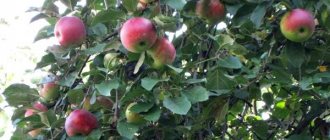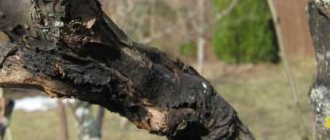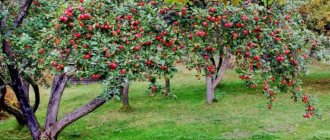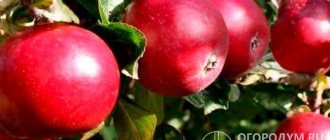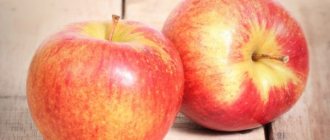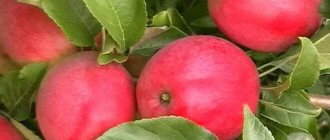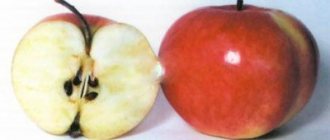Gardening » Apple tree
0
444
Article rating
Kira Stoletova
Apple tree Autumn Joy is the result of selection work by Isaev S.I. - scientist from VNIIS named after. I.V. Michurina. To develop this early autumn variety, two hybrids were crossed – the mother “Welsey” and the daughter “Cinnamon Striped”. Subsequently, the resulting seedlings were grown in spartan conditions (on low-nutrient soils at low temperatures), which developed in them high resistance to cold and most common diseases. Let us consider in a little more detail the description of the quality parameters of this variety.
Apple tree variety Autumn joy
Description, photo
Breeder S.I. Isaev on the basis of the All-Russian Research Institute of Horticulture named after I.V. Michurina developed this hybrid by crossing “Cinnamon Striped” and “Welsey”. “Welsie” was used as the mother one.
Through stage-by-stage pollination we managed to obtain this wonderful hybrid. And hardening off and growing on depleted soils has developed a relatively high resistance to low temperatures and diseases.
The tree is tall, round in shape and has a rich crown. The bark of the trunk and skeletal branches is brown. The shoots are straight, large in cross-section, with noticeable pubescence. On the stems there is a small number of round, light yellow lenticels.
The leaf is wrinkled, ovoid, slightly elongated, medium in size and dark green in color. There is wavyness along the edge of the leaf.
The apples are not very large, on average 120 - 130 g , regular rounded in shape, slightly tapered towards the top. The color of the fruit is green-golden, covered more than half with a bright red blush with faintly highlighted strokes.
The stalk is of medium size and slightly extends beyond the wide, but not deep, funnel. Medium-sized brown ovoid seeds with a red tint.
Apple tree fruit Autumn joy.
additional characteristics
Advantages and disadvantages
The main advantages are:
- High frost resistance;
- Stability of a good harvest;
- Presentation, size and dessert aroma of fruits;
- Good resistance to scab.
The downside is:
- Direct and sharp growth of skeletal branches;
- Poor formation of new shoots;
- Wood fragility in seedlings.
Sizes of an adult tree and annual growth
This is a tall apple tree.
Attention! Without proper formation, it can grow up to 12 m.
Amateur gardeners note weak annual growth.
Productivity. Frequency of fruiting
The apple tree is distinguished by regular and stable annual harvests . With proper care and creation of the required conditions, it produces a harvest of about 90 kg. An adult 20 year old can produce up to 150 kg.
Autumn joy is characterized by regular and stable harvests.
Tasting assessment
This variety has white flesh with a slightly creamy tint. The structure is medium-dense, tender, juicy. With a sweet and sour dessert taste, spicy aroma and high sugar content. There is a high tasting score - 4.3.
Winter hardiness and disease resistance
It is resistant to winter temperatures. There is also an increase in immunity to diseases such as scab.
Watch the video of what the Autumn Joy apple tree looks like:
Good and negative characteristics of the variety
Optimistic gardeners among their “colleagues” praise “Autumn Striped” for its undoubtedly positive qualities:
- Ultra-high and stable yields for young trees;
- Unsurpassed taste and aroma qualities. Admirers of the variety and experts rate the taste of the fruit 4.5 points out of 5.
- The ability of fruits to be stored for up to three months and transported over long distances;
- High resistance to winter cold and the ability to restore damage received after severe frosts;
- “Streiflen,” as the variety of apple trees in question is also called, is well resistant to many popular pests and diseases in gardens in the middle zone, especially the dangerous “apple” disease – scab.
- The tree is responsive to the correct agricultural techniques of growing, fertilizing, watering, pruning;
- The “Autumn Striped” variety is valued for its durability. Fruiting, with proper care of the crop, can last for several decades.
Pessimistic gardeners begin to characterize “Streiflen” with its unattractive qualities:
- Apple trees bear fruit after planting quite late, on average in the seventh year, and the increase in yield over the years is very insignificant. At the same time, gardeners forget that by the age of 30 a tree is capable of producing over three hundred kg of marketable fruit;
- The tree is bulky and occupies a large area of the garden;
- Tall growth up to 10 meters makes harvesting difficult;
- Old apple trees may exhibit periodicity in fruiting;
- Taste characteristics depend on seasonal weather conditions;
- The tree requires regular irrigation and does not tolerate dry periods;
- The culture is not self-fertile and requires pollinators.
Reviews
Igor. “Great hybrid. In many respects it surpasses Melba in our region. Planted 15 years ago and has never failed in winter. In the last couple of years, winter hardiness has been making itself felt. Either the tree has aged, or the frosts have become stronger. But this does not greatly affect the harvest. Only part of the fruit buds freezes.”
Alina O. “I can’t say that this is an ideal variety. But among the early autumn ones it is really good. I especially like the taste of the fruit. In most cases, we use apples for compotes and liqueurs for the winter. So, the spicy aroma suits us well for preparations.”
Tatiana. “10 years ago we planted an orchard and the main preference was given to Isaevsky varietal material. There are, of course, two trees of “Autumn Joy” among them. Fruiting began in the 5th year. Now apple trees produce approximately 60 kg of delicious (in our opinion) large apples. Thanks to the creators of this miracle."
Features of planting and care
A mandatory requirement for cultivating this crop is to check the groundwater level. Level mobility is considered ideal. Its rise after the snow melts can destroy the apple tree after rotting and death of the root system.
Another important factor is the mineralization of these waters, swampiness of the area, sandy soil, close proximity to the surface of limestone slabs, crushed stone or dense clay soils.
All these factors are not conducive to the good development of culture.
Landing
Deadlines
This crop can be planted both in spring and autumn. But the ideal conditions for this variety are still considered to be the last ten days of March until mid-April.
Technology
- As with any fruit tree, the planting hole is prepared in advance.
- A hole 60 cm deep and about 1 m wide is prepared for the seedling.
- The necessary fertilizers and rotted organic matter are placed at the bottom.
- Then the hole is filled with water and the seedling waits for 10 days, which should be placed in a container with water a day before planting to fill the roots.
- Damaged roots of the seedling should be cut off.
Planting pit preparation diagram.
Watch the video on how to plant an apple tree:
Distance
The distance is determined by varietal characteristics. For “Autumn Joy” it should be at least 4 m between plants.
Growing
The apple tree loves a high, illuminated place and non-acidic soil. Not very demanding when growing. Due to its pollination properties, it is better not to alternate plantings with other types of fruit trees.
Agricultural technology
Caring for the plant continues all year round:
- In spring: remove branches that are damaged and dried out over the winter;
- treat and heal wounds.
- pest control;
- whitewashing of the trunk;
Attention! When preparing for winter, it is worth considering the possibility of contracting other diseases. Therefore, fallen leaves must be removed from under the plant.
Crown trimming and shaping
The formation of the crown is of great importance for the fruiting of the plant. A sufficient amount of sunny leaves makes it possible for the plant to receive the required nutrition. If it is deficient, the fruits will not gain sufficient flavor. Without proper pruning, the crop will quickly grow quite tall and make harvesting difficult.
You need to start pruning from a very early age. When planting a seedling, it is shortened by a third. In the future, formation is carried out annually. If you trim the growth by a quarter of its length every year, the lateral branches will develop well.
Formation of the crown of an apple tree.
Don't forget about sanitary pruning. Damaged, dry branches need to be promptly cut out and the crown thinned. Otherwise, the plant may get sick and die.
Watch a video review of how to prune an apple tree:
Pollinator varieties
The apple tree variety Autumn Joy is pollinated exclusively by insects . Therefore, it does not require pollinating varieties.
Pests and diseases
Apple trees of the “Autumn Joy” variety are not very susceptible to diseases, however, there are also diseases that arise due to human fault.
Such diseases include: bacterial burn, black cancer, cytosporosis.
These diseases must be combated as follows:
Black cancer. It is very important to prevent this disease from entering your area, since it is mainly transmitted on the roots of young seedlings. Seedlings with large growths should be thrown away. If small growths are found on the seedling, they need to be removed and the apple tree disinfected. As a preventative measure, applying potassium fertilizers is suitable.
Cytosproz. When fighting this disease, you need to trim off diseased branches and disinfect the tree.
Bacterial burn. When fighting fire blight, you need to remove damaged branches and disinfect the tree. A pest invasion can greatly worsen the condition of an apple tree.
The main pests are:
Green aphid. To combat green aphids, you need to spray the tree with Bordeaux mixture.
Hawthorn. To destroy these caterpillars, you need to treat the apple tree with Actellik.
Apple codling moth. The first measure is to remove the damaged ovary; later the tree must be treated with the drug enterobacterin.
To summarize, we can say that apple trees of this variety are well prepared for growing in households. Apples are very juicy and are well suited for fresh consumption or canning. The main disadvantage of this variety is the short shelf life of apples, which makes it of little interest to industrial gardeners.
Features of ripening and fruiting
Fruiting
Start
It has an average fruiting period, which begins 4–5 years after planting . The tree produces its first normal harvest in the 7th year.
Autumn Joy gives a full harvest in the 7th year.
Peculiarities
Fruiting occurs at the tips of shoots of the vegetative type, but, for the most part, on fruit twigs.
After ripening, the apples hold well on the branches. But it’s still better not to overexpose them.
Attention! When left on the tree for a long time, they begin to crumble.
Deadlines
Blooms
Blooms in May. The duration of flowering depends on the temperature. The lower it is, the longer the flowering will continue.
Fruit ripening and storage
The apples are poured in September. Storage in the refrigerator or cellar is up to two months . At the same time, the fruits do not lose their appearance and taste.
The fruits of the Autumn Joy apple tree ripen in September.
Collection and storage
The fruits of the Autumn Joy apple tree are harvested from late summer to mid-autumn, depending on weather conditions. Maturity is determined by appearance (rich golden color with red stripes and strokes). They also check the condition of the skin - you need to press it well. If the dent does not form, you need to wait a few more days. If the skin breaks easily, this is a clear sign of overripeness: such apples can be used to make jam.
Only undamaged fruits can be stored. Each apple is wrapped in paper and kept at temperatures up to +5 ° C, in a dark place with high humidity up to 90%. If the apples are damaged, they are sent for processing.
Apple tree Autumn joy
Some famous gardeners believe that “Autumn Joy” does not rightfully occupy a place in the third ten autumn varieties. In terms of its indicators, it should be much higher and outperform its brothers of the same selection from Brown Tabby and Welsey:
- "Young Naturalist"
- "Aelita";
- "Lungwort";
- "Cinnamon is new."
Both in size and taste.
Young naturalist.
Aelita.
Lungwort.
Cinnamon is new.
On a dwarf rootstock
Such species are not found in industrial horticulture. Some amateur gardeners grow on dwarf and semi-dwarf rootstocks. But these are isolated cases occurring in the southern regions.
Altai
Early autumn, low-growing, hybrid with a rounded crown shape. Skeletal branches are also located at an acute or right angle. The fruits are half the size and average 50 g.
Apple tree Autumn joy of Altai.
The advantages of this culture can be considered:
- Good yield;
- Precociousness;
- Small height;
- Relative resistance to scab.
Disadvantages : small apples and low winter hardiness.
Look at the video characteristics of the Autumn Joy of Altai apple tree:
Growing in regions
This type of apple tree was zoned specifically for the Central region. It is successfully grown according to recommendations in a relatively harsh climate and unfavorable fruit growing conditions. These include the Central and Central Black Earth regions.
In outskirts of Moscow
For the Moscow region, this hybrid is considered one of the successful varieties. No special growing conditions are required in this region. It is necessary to adhere to the classical rules of caring for these fruit crops.
In Altai
When grown in the Altai climate, special conditions are also not required.
This plant is unpretentious to growth conditions and therefore experienced breeders recommend it for cultivation in a relatively harsher climate than the central part of Russia.
For better adaptation, timely feeding is required, which not only promotes development, but also increases winter hardiness.
In Siberia
Advice! In the Siberian region, where frosts often reach 30-40° C, this hybrid is not recommended for cultivation.
If you grow it, then only on slate rootstocks or wrap the plant well in winter , with a bulk sprinkle of humus around the trunk.
In Siberia, Autumn Joy is best grown in stale form.
Region of natural growth
The hybrid has become popular in Ukraine and Belarus. Although the variety thrives in harsh climates, it is not recommended to grow it in Siberia.
But initially the hybrid was intended for cultivation in the following regions of Russia:
- Ivanovskaya;
- Moscow;
- Smolenskaya;
- Ryazan;
- Tula;
- Kaluzhskaya;
- Vladimirskaya;
- Tverskaya;
- Bryansk;
- Yaroslavskaya.
During heat and drought, the apple tree must be watered periodically. In spring, nutrients need to be added to the soil in dissolved form. It is impossible to do this in dry soil. It should be watered abundantly, otherwise depletion of the tree cannot be avoided.
Apple trees grow well in cold conditions. To speed up adaptation, it can be fed. For young trees, the recommended frequency of the procedure is twice a year, for adults – once. It is better to use organic fertilizers.
